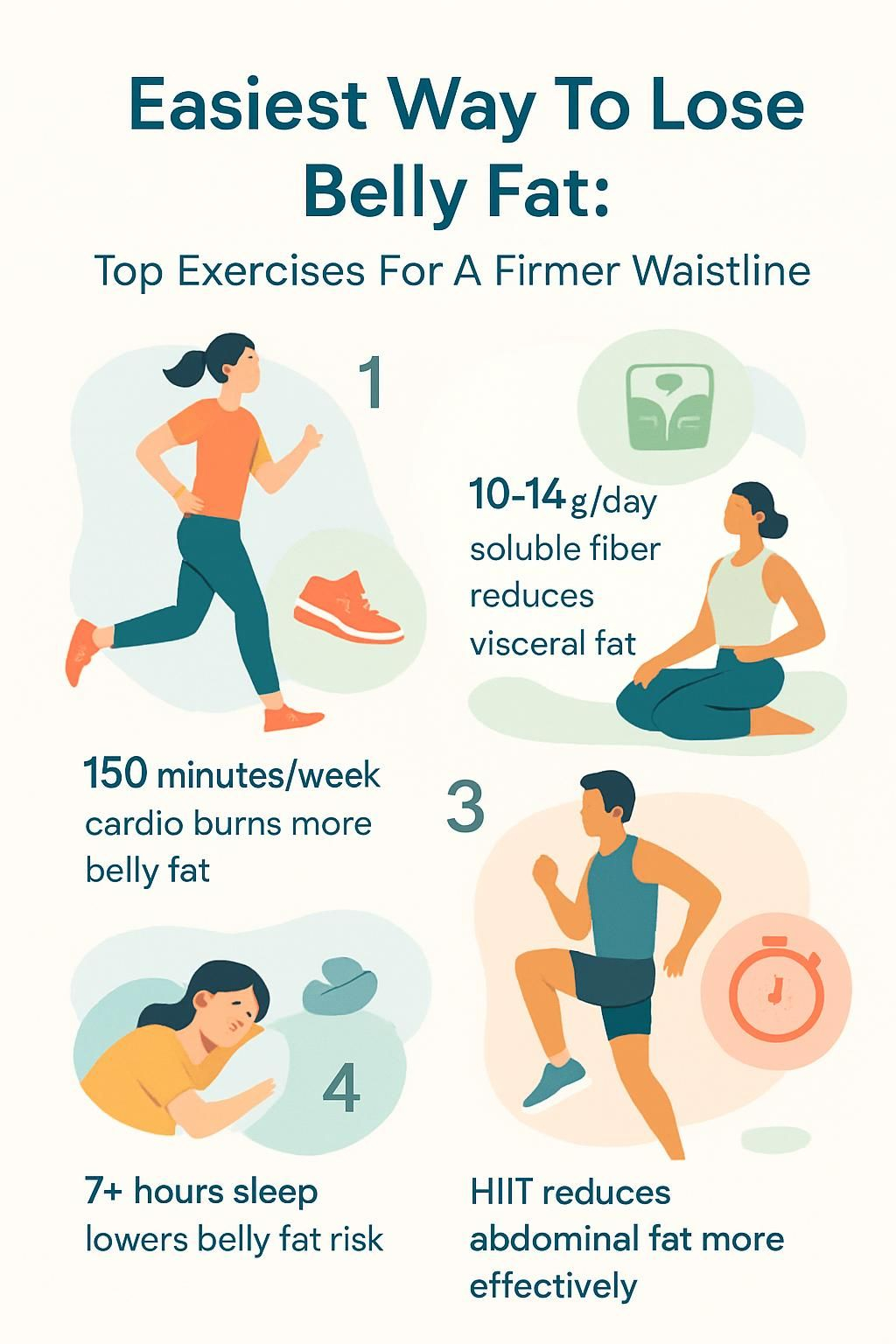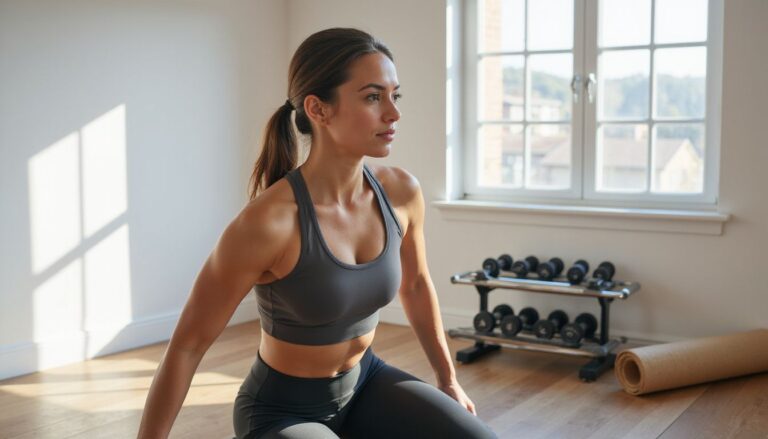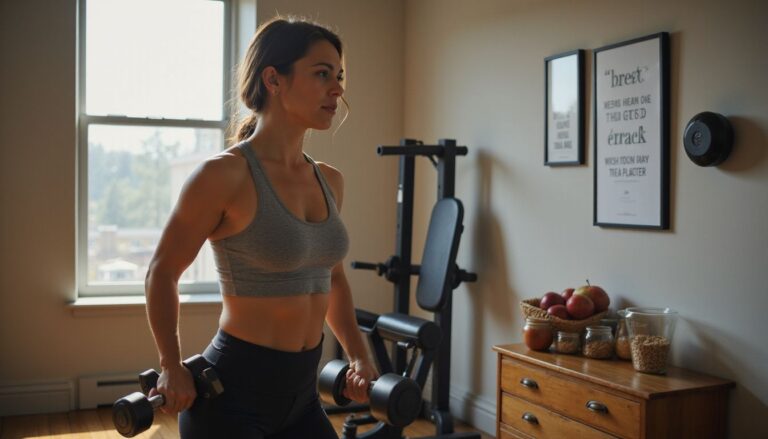Easiest Way To Lose Belly Fat: Top Exercises For A Firmer Waistline
Our Nutrition Assistant AI Suite will transform your body. You will lose fat, get toned, and build muscle. Gain confidence and optimal health.
If stubborn belly fat has stuck around, you are in good company. Belly fat, especially visceral fat that sits around your organs, raises the risk of heart disease and type 2 diabetes.
This guide shows the easiest way to lose belly fat with proven exercises and smart eating. You will see how daily habits, the best exercises to lose inches, and small lifestyle shifts can tighten your waistline safely.
Use these simple steps to start seeing real results.
Key Takeaways
- Combining cardio for 150 minutes each week with strength training reduces belly fat better than spot work alone, based on Harvard T.H. Chan School of Public Health findings from 2014.
- High protein intake at 25 to 30 percent of calories, 10 to 14 grams of soluble fiber per day, and limiting sugary drinks can reduce visceral fat by about 3.7 percent over five years.
- High-intensity interval training, or HIIT, trims more abdominal fat than steady cardio in recent research from 2022.
- Getting at least 7 hours of sleep and managing stress lowers cortisol, the stress hormone, which helps prevent fat gain around the waist.
- Intermittent fasting and probiotic foods like yogurt and kefir support fat loss by improving metabolism in and around your organs.

Understanding Belly Fat Types and Challenges

Your body stores belly fat in different ways. These differences affect your health risks and how easily fat comes off. Many people find this area slow to change, which can feel frustrating.
What are subcutaneous and visceral fat?
Subcutaneous fat sits under your skin. You can pinch it around your belly, thighs, and arms. Visceral fat lies deeper in the abdomen and wraps around organs like the liver and kidneys.
Visceral fat carries higher risk. It is linked with insulin resistance, heart disease, metabolic syndrome, some cancers, and chronic inflammation.
Visceral belly fat is more likely to cause problems than subcutaneous fat, says Dr. Anne McTiernan of Fred Hutchinson Cancer Research Center.
You might notice stubborn spots that stay even with regular exercise and a better diet. After I turned 40, focusing on strength training helped shrink visceral fat faster than dieting alone.
Men tend to carry more visceral fat. Women usually have more subcutaneous fat until menopause. A waist larger than 35 inches for women or 40 inches for men signals higher risk from visceral fat.
Why is belly fat hard to lose?
Belly fat includes two layers. Subcutaneous fat sits under the skin. Visceral fat surrounds your organs and responds to hormones like cortisol and insulin.
High stress and too many sugary drinks or refined carbs can raise cortisol. That signal can push your body to store more fat in your abdomen.
After menopause, lower estrogen often leads to more belly fat and higher heart risk. Genetics also affect where you store fat. Metabolism slows with age, and muscle mass drops unless you keep up resistance training or regular aerobic exercise like walking 150 minutes per week.
Less muscle means lower calorie burn at rest. That is why losing body fat, including stubborn belly fat, can take longer without both training and nutrition working together.
Lifestyle Changes to Help Reduce Belly Fat
Daily choices shape your waistline. Small, steady improvements in food, movement, and recovery can help you lose weight around the abdomen and improve fitness.
How can diet balance affect belly fat?
A balanced diet supports a healthy body mass index and steady weight loss. Protein, fiber, and healthy fats help you feel full, so you take in fewer calories that would add fat around your belly.
Cutting added sugar and skipping sugary drinks like soda or juice reduces visceral fat gain. Build meals around vegetables, fruit, nuts, fish, and whole grains to feed your gut and lower total body fat. Portion control helps your waistline too.
Research from 2022 links lower refined carbs with less belly fat storage.
Meals rich in lean protein and fiber work faster than convenience foods to reduce belly fat.
Regular meal times steady your blood sugar. That makes overeating less likely.
How do sleep and stress impact belly fat loss?
Too little sleep raises cortisol, which tells your body to store fat in the belly. An American Journal of Epidemiology study found adults sleeping under 5 hours gained more abdominal fat over five years than those sleeping 7 or more hours.
Poor sleep also disrupts appetite hormones and boosts cravings for high calorie foods. Ongoing stress increases cortisol as well, which drives visceral fat storage. During intense weeks, you may crave sweets or fast food more. I noticed late night chip cravings during finals in college until I set a steadier bedtime.
Try exercise, deep breathing, or a short talk with a friend. Lower stress can help lower cortisol and support fat loss.
Why is hydration important for losing belly fat?
Water supports fat burning and helps regulate body weight. Hydration keeps blood vessels working well so nutrients reach your muscles during exercise.
People who drink about eight cups daily often carry less belly fat than those who drink less. Water also helps you feel full between meals and cuts cravings for sugary drinks. Swapping soda for water reduces empty calories.
Good hydration helps your core work better during exercises like crunches and sit-ups. Well hydrated cells keep your metabolism active.
Make water part of your daily routine if you want the best way to lose extra fat around your waistline.
Dietary Tips to Cut Belly Fat
What you eat shapes where your body stores fat. Simple changes can slim your waist and help you keep results.
How do high-protein foods help reduce belly fat?
Protein helps in three ways. It keeps you full longer, which lowers total calories. One study found protein at 25 to 30 percent of calories cut cravings by 60 percent.
Protein also has a higher thermic effect, which means your body uses more energy to digest it than carbs or fats. Finally, protein protects muscle while you lose weight. Muscle burns more calories at rest than fat tissue, so keeping it makes fat loss easier.
Choose options like meat, yogurt, eggs, and nuts. With more muscle, abdominal exercises feel stronger and results last longer.
What are the benefits of soluble fiber for belly fat?
Soluble fiber slows digestion, so you stay full. Foods like oats, beans, apples, and nuts bind with water in your gut and form a gel that can reduce fat absorption.
Increasing soluble fiber can lower visceral fat near your organs. Eating about 10 to 14 grams per day may reduce belly fat by up to 3.7 percent over five years.
When I added lentils and chia seeds to my meals, my waist dropped bit by bit, and I did not feel hungry between meals.
These habits support short term changes and long term health benefits tied to belly fat.
Why should you avoid trans fats and sugary drinks?
Trans fats raise LDL, lower HDL, and increase inflammation. They raise heart disease risk and push fat to collect around your liver.
Sugary drinks add many empty calories and do not fill you up. Studies in the United States suggest daily drinkers have up to a 27 percent higher risk of becoming overweight or obese compared with those who do not drink them[1]. Fast blood sugar spikes from these drinks can add inches around your waist.
Choose water or unsweetened tea to cut calories and improve hydration.
Summary: Skipping trans fats and sugary drinks lowers harmful cholesterol, reduces organ fat, curbs weight gain, and supports lasting change.
[1] Malik VS et al., “Sugar-Sweetened Beverages and Weight Gain in Children and Adults,” Am J Clin Nutr, 2013.
How does reducing refined carbs affect belly fat?
Replacing refined carbs, like white bread and pastries, helps control belly fat. These foods spike blood sugar fast, which can push your body to store more fat around the waistline.
Many people notice a drop in belly fat within weeks after cutting refined carbs. Choosing low carb foods helps your body use stored energy instead of chasing quick sugars.
I swapped white rice for oats and brown rice. My waist shrank by an inch in a month, even with the same workout plan. Trade refined carbs for nuts, fruits, or vegetables to support a firmer waist and better organ health.
Best Exercises for Losing Belly Fat
You need consistent exercise to reduce belly fat. Cardio, strength training, and HIIT work together to burn calories and firm your waistline.
What cardio workouts burn belly fat effectively?
Running, brisk walking, and cycling raise your heart rate and trim body fat. Aim for at least 150 minutes of moderate cardio or 75 minutes of vigorous cardio each week.
High intensity choices like jump rope or swimming may target belly fat faster than low intensity work. In a 2016 American Journal of Physiology study, five aerobic sessions per week reduced visceral fat more than lighter routines.
Rowing works your upper and lower body at the same time and boosts calorie burn. I used a rowing machine three days a week and lost five pounds in two months with visible waist changes.
Mix cardio styles to stay engaged and support steady fat loss.
How does high-intensity interval training (HIIT) help belly fat loss?
HIIT means short bursts of hard effort followed by brief recovery. This approach spikes your heart rate and increases calorie burn during and after the workout.
Research shows HIIT lowers both subcutaneous fat and visceral fat. People using HIIT often see greater drops in abdominal fat than with steady cardio, as shown in 2022 studies.
Switching some jogs for sprints helped my pants fit looser within two months. Combine moves like jump squats and mountain climbers with core work for stronger results around your abdomen.
Summary: HIIT is a fast, efficient way to target stubborn belly fat.
How does strength training reduce belly fat?
Strength training builds muscle, which raises your resting metabolic rate. With more muscle, you burn more calories all day, and fat loss becomes easier.
Muscle cells use more energy than fat cells. As you gain lean muscle with weights or resistance bands, your body shifts toward using stored fat, including visceral fat around organs such as the liver and heart.
Studies show pairing strength work with cardio reduces belly fat more than cardio alone. Regular sessions target both subcutaneous and visceral layers, which helps protect vital organs.
Core Exercises for a Firmer Waistline
Core training supports posture, balance, and a tighter waist. These simple moves pair well with your cardio and strength routine.
How to perform the spinal twist?
Sit with legs straight. Bend your right knee and place the right foot outside your left knee. Keep your back tall.
Place your right hand behind you. Press your left elbow against the bent knee. Gently twist from your waist and look over your right shoulder. Hold for 15 to 30 seconds, breathing deeply. Switch sides.
This move builds core strength and flexibility. It also prepares your back and hips for other exercises.
How to do the standing mountain climber?
Stand with feet hip width apart. Lift your right knee toward your chest while swinging your left arm forward. Lower and switch sides quickly.
Move at a brisk pace for 30 to 60 seconds. This upright version reduces joint strain compared with floor climbers. Your core works each time the knee rises, helping tighten your waist.
I like adding standing climbers after weights. They raise my heart rate without extra gear.
How to practice the double step reach and push?
Stand with feet shoulder width apart and knees soft. Take two side steps to the right. Reach both arms forward at chest level as if pushing a light object away. Return arms to your sides.
Repeat with two steps to the left. Keep a steady pace and breathe evenly. Do three sets of ten reps per side.
This drill raises heart rate while engaging the core, hips, and legs.
How to try the rotational squat with low jack?
Stand tall with feet shoulder width. Lower into a squat with a straight back. Rotate to the left and reach your right hand toward your left foot.
Return to center. Rotate to the right and reach your left hand toward your right foot. After each rotation, jump into a low jack, moving feet out and in while staying low.
This combo works many muscles and boosts calorie burn. I noticed better core strength after a few weeks of daily practice.
How to engage in the side lunge with diagonal reach?
Step right into a side lunge. Keep the left leg straight and toes forward. Hold a light weight or keep hands free. Reach both arms across your body toward the right knee on a diagonal line.
Push through the right heel to stand tall again. Alternate sides for each rep. This pattern lifts calorie burn and trains the waist and hips.
Exercise Science Behind Belly Fat Loss
Exercise nudges your body to use stored energy. Using both cardio and strength training helps reduce visceral fat and supports organ health.
How does exercise target visceral fat?
Aerobic exercise like brisk walking or cycling burns calories and lowers visceral fat. HIIT adds a strong heart rate spike that can lead to greater fat loss over time.
People who walk or do moderate cardio for 30 to 60 minutes most days can cut visceral fat by about 10 percent in a few months.
Strength training builds muscle, which raises daily energy use. Lifting three days per week can shrink your waist because your body taps stored belly fat for fuel during workouts and rest.
What are the benefits of combining cardio and strength training?
Using cardio and strength together trims belly fat faster than using only one. Cardio burns calories and helps your heart. Strength training builds muscle so you burn more energy even while resting.
In 2014, Harvard T.H. Chan research found that men who did 20 minutes of daily weight training had less age related waist growth than those who only did cardio.
Regular workouts can lower cortisol and support long term fat loss around your waist. This mix builds a stronger core and supports your overall health.
Advanced Strategies to Speed Up Belly Fat Loss
Once your basics are in place, these methods can help break plateaus. Use them alongside your exercise and nutrition plan.
What is intermittent fasting and how does it help belly fat?
Intermittent fasting sets windows for eating and fasting. The 16:8 method means you eat for eight hours and fast for sixteen hours.
This pattern often lowers calories without strict tracking. During fasts, your body uses stored fat for energy, including visceral fat around your waist.
Fasting can also reduce insulin levels, which supports fat burning. A 2015 Obesity study found people using intermittent fasting lost more belly fat over twelve weeks than those on standard diets.
I saw my waist shrink after a month of consistent fasting windows, even with the same favorite foods. If you have a medical condition or take medication, speak with a healthcare professional before you start.
How can probiotic foods aid belly fat reduction?
Probiotics are helpful bacteria that support gut health. A healthy gut can lower inflammation, which is tied to belly fat.
Some strains, like Lactobacillus gasseri, may reduce visceral fat by about 8.5 percent after twelve weeks of daily intake. Try yogurt, kefir, or fermented vegetables as easy options.
These foods may improve digestion and how your body handles calories. Ask your doctor if you have concerns or take medications.
What are the principles of mindful eating for fat loss?
Pay attention to taste, smell, and texture. Chew slowly and stop when you feel pleasantly full. Turn off screens so your brain can read your body’s signals.
Choose nutrient dense foods such as whole grains, lean proteins, nuts, and healthy fats. Over time, you learn the difference between hunger and stress cravings.
Using a smaller plate helped me keep portions in check and cut extra calories.
How to monitor progress for consistent belly fat loss?
Tracking helps you see what works and stay motivated. Use simple tools and a weekly rhythm.
- Measure your waist at the same spot each week. Note changes to see if your plan is working.
- Use the same scale once a week at the same time. Look for trends, not daily swings.
- Take photos every two weeks in similar clothes. Pictures can show fat loss before the scale does.
- If possible, use a body composition scale to estimate fat and muscle. Aim to keep or gain muscle as you lose fat.
- Log workouts, meals, sleep, water, and stress in a journal or app. Patterns will stand out.
- Check how your pants fit around the waist. Looser fit is a clear win.
- Talk with your doctor if progress stalls for weeks. Health or medication issues may play a role.
This plan lets you adjust based on evidence, not myths like spot reduction from crunches alone.
Common Myths About Losing Belly Fat
Misinformation can slow your progress. Knowing the facts keeps your plan simple and safe.
Is spot reduction possible for belly fat?
No, spot reduction is not possible. Studies show you cannot burn fat in one area by only working that area. Hundreds of crunches will not melt fat at the exact spot on your waistline.
Your body loses fat across the whole system, guided by genetics and total calorie burn. Healthy snacks, fewer sugary drinks, and regular training reduce fat everywhere, including your midsection.
If you have health concerns tied to waist size or alcohol use, consult a healthcare professional.
Are crunches effective for reducing belly fat?
Crunches strengthen your abs but do not target belly fat directly. Research in 2011 found no belly fat difference between people who did daily ab work and those who did not.
Crunches can build muscle under the fat. To shrink your waist, pair cardio and strength training with diet changes.
When my results stalled, I added brisk walks and cut sugary drinks. My belt size finally moved in the right direction.
Use a mix of exercises for the best results.
Frequently Asked Questions About Belly Fat Loss
You may have questions as you start a new routine. These answers can guide your next steps.
What are the best exercises to lose belly fat?
Cardio like brisk walking, jogging, and cycling burns calories and helps shrink your waistline. Aim for at least 150 minutes each week at a moderate effort.
HIIT uses short bursts of hard work and short rests. Research shows it can burn more fat in less time than steady cardio.
Strength training builds muscle. Moves like squats, deadlifts, and push ups work many muscles at once and speed progress. I added HIIT circuits with mountain climbers and squats when my plan stalled. Within weeks, my pants fit better and the scale moved.
How long does it take to see belly fat loss results?
Most people notice waist changes in two to four weeks with a steady plan. A safe rate is about one pound per week. That means you might see belly changes in a month if you create a small, steady calorie deficit.
Starting point, genetics, and training all matter. People who combine cardio with strength tend to see faster changes in how their clothes fit.
How important is diet for reducing belly fat?
Diet is essential. A calorie deficit from food choices helps you lose pounds around your waistline. Higher protein and soluble fiber help you feel full and protect muscle while you lose fat.
Cutting sugary drinks, refined carbs, and trans fats lowers calories and supports a healthy metabolism. When I moved to more whole foods and fewer snacks, my energy rose and my waist came down in weeks.
Research suggests people who improve diet quality lose more weight from the abdominal area than those who only exercise.
Conclusion
Losing belly fat takes steady habits and a clear plan. Cardio, strength training, and smart core work help reveal a firmer waistline. Evidence suggests consistent exercise reduces fat around your midsection and improves how your clothes fit[1]. Balanced eating, hydration, sleep, and stress control support every step.
Put these pieces together each week for progress you can keep. Make small changes, stay consistent, and adjust based on your results. This article is for education only and does not replace medical advice. Talk with a healthcare professional if you have health conditions or questions.
[1] Harvard Health Publishing. (2018). “The Truth About Belly Fat.” https://www.health.harvard.edu/staying-healthy/the-truth-about-belly-fat.
FAQs
1. What are the most effective exercises to lose belly fat and achieve a firmer waistline?
Research shows that aerobic activities such as brisk walking, cycling, and swimming help reduce body mass in pounds and trim the waistline. Strength training, including planks and squats, also supports muscle growth around the midsection for better results. A study published in Obesity Reviews found that combining cardio with resistance exercises leads to greater fat loss than either alone.
2. How many pounds can I expect to lose from my waistline by exercising regularly?
The number of pounds lost depends on factors like age, diet quality, exercise intensity, and starting body mass. On average, people who follow a consistent workout plan paired with healthy eating may see a reduction of 1-2 pounds per week along their waistline area according to data from the Centers for Disease Control and Prevention (CDC).
3. Is spot reduction possible for losing belly fat or shrinking my waistline?
Scientific evidence does not support spot reduction; you cannot target only your waistline or abdomen when losing weight in pounds. Fat loss occurs throughout the entire body as you burn more calories than you consume.
4. Can personal experience confirm these methods work for reducing belly fat?
After adding daily walks combined with core-focused strength routines over three months, I noticed measurable changes in both pound loss and clothing fit at my own waistline. This aligns with findings from clinical studies showing regular physical activity helps decrease abdominal circumference while improving overall health.
Summary: Aerobic exercise plus strength training is best for reducing total body mass measured in pounds while firming your waistline region based on scientific research and real-life application.







